Leanne: Thanks everyone for joining us today. We are going to begin by talking about how important interdisciplinary research is to our profession, and to healthcare in general. We are then going to introduce to you our FAIRR model. FAIRR stands for Forging Alliances In Rehabilitation Research. We are going to end with using our model to show examples of how we have embarked on research careers, and show you segments of the model so you can apply it to your own research goals and trajectory.
Background and Significance
Let's start with the backgrounds and significance of this topic. Interdisciplinary research has been a priority for a very long time, but there is an increased interest in the last five years. Our profession, specifically The American Occupational Therapy Association (AOTA), American Occupational Therapy Foundation (AOTF), and bodies outside our profession, have stressed the need to cross bridges and be productive with other members of the research world (Chan, Heinemann, & Roberts, 2014; Richards, 2015; AOTA & AOTF, 2011; AOTF, 2015). We need to increase research capacity to be more productive in our research goals.
Defining Terms
We want to start off by clarifying some different terms. This talk is focused on interdisciplinary research. However, often you will hear very similar terms which include: multidisciplinary, transdisciplinary, transprofessional, and interprofessional. We feel that multidisciplinary is probably the term that is most commonly used with interdisciplinary research so that is the one we are going to focus on. We will also explain the difference between multidisciplinary and interdisciplinary.
Multidisciplinary
I think one of the main differences between the terms multidisciplinary and interdisciplinary is that there is really one dominant discipline, or one dominant profession in multidisciplinary. That dominant profession guides what is going on with the research project. Usually the language that is used is the language is most familiar to that dominant discipline. Although members of the team are working together, it is one profession that is driving the agenda (Dijkers, Murphy, & Krellman, 2012; Aboelela et al., 2007).
Interdisciplinary
Interdisciplinary is more of a mesh of multiple worlds together. There are multiple clinicians and scientists working together for multiple disciplines. There is also a common or shared language. For example, I am an occupational therapist, and I talk about occupations. This is a language very familiar to our profession; however, I am not sure that my colleagues, physicians, or nurse practitioners would understand that term. I might choose to use a more familiar term like activities or routines. Together, we would develop language that is familiar to everyone.
This quote by Grossman (1979) nicely captures what we mean by interdisciplinary research.
“Joint, coordinated, and continuously integrated research done by experts with different disciplinary backgrounds, working together and producing joint reports, papers, recommendations, and/or plans, which are so tightly and thoroughly interwoven that the specific contributions of each researcher tend to be obscured by the joint product”
Interdisciplinary science and research is not new as it has been around for a long time. However, due to multiple factors, which we will discuss, the time is right to merge with other professions and put our resources together to achieve great outputs. Jean Ayres, a pioneer of our profession, is one example of someone who engaged in interdisciplinary research. We all know Jean Ayres for her sensory integration research, but she had a PhD in Education in addition to OT. She used her knowledge from both worlds to develop her sensory integration approach. We are now going to talk about how the timing is right for us to go into interdisciplinary research.
The Timing is Right
Mary: We are really not alone as a profession when we consider pursuing interdisciplinary efforts in research. This is an ongoing point of debate as many of us are situated at institutions that emphasize different things. Part of what shapes our decision making about whether to pursue interdisciplinary research is timing. It is not just about where you are, but rather, it is about when you get there and what things are like when you are there. The timing is really right now for interdisciplinary research efforts.
- Grant funding rates make interdisciplinary research a sustainable strategy.
- Initiatives that support interdisciplinary science:
- National Institutes of Health (NIH)
- BIRT: Building Interdisciplinary Research Teams
- CTSI: Clinical and Translational Science Institute
- AOTF Intervention Research Grant
- National Institutes of Health (NIH)
- Co-first authorship and multiple PI (primary investigator) options reward interdisciplinarity
There are formal initiatives from the National Institutes of Health, The National Science Foundation, and even AOTF. Interdisciplinary teams are coming together to address a larger question that is not unique to a single discipline. Within the funding mechanisms, there are new mechanisms for even sharing intellectual credit. These are being formally laid out and pursued by individuals who are forming or building their interdisciplinary teams.
One example of this is a multiple principle investigator, or multiple PI options, for joint leadership on an interdisciplinary research project. Credit is assigned to multiple points of leadership for that project. There are also formal options for co-first authorship. Once you have completed a project and are looking to disseminate your research findings, there are formal mechanisms to reward interdisciplinary efforts at that end, as well.
Figure 1 emphasizes the broad range of funding opportunities that we have come across in our careers to date.
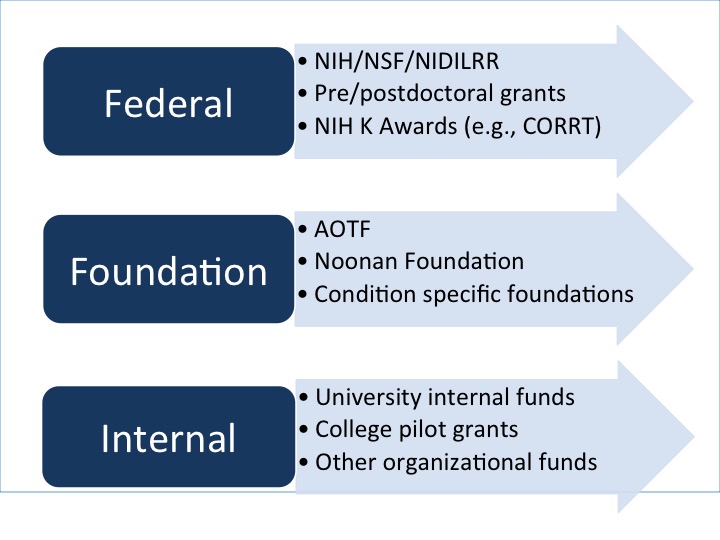
Figure 1. Examples of funding opportunities.
These possibilities, for securing resources to pursue interdisciplinary research, are viable across one's career. For example, the NIH K Award, that is listed in the federal grant category, is something that is a viable mechanism to pursue both in the earlier stages of one's career and at the mid-level. Once one is a little bit more established in their career, this award might allow them to go in a new direction.
Benefits
There are many benefits, both to an individual occupational therapist, but also to the profession, by pursuing interdisciplinary work and scholarship. The individual can benefit both conceptually and methodologically in scientific growth by joining teams and learning new concepts or approaches for investigating a concept. For example, if one is interested in the concept of participation, which is a key outcome in our profession, via an interdisciplinary research effort, we might be introduced to a new method for being able to examine that outcome.
There are also benefits to the individual in terms of being able to get funding and get resources to do one's work. Other benefits to the profession include an increased network of colleagues and dissemination possibilities. When you are on team with individuals who have experience in publishing, disseminating their work, communicating it to new venues, or being able to reach out and get feedback from additional networks, this can help you. You might not have this opportunity as a solo investigator. This brings new possibilities for extending the impact of one's work.
Challenges
While there are many benefits both to the individual and to the profession as listed above, there are also a host of challenges that are worth mentioning and recognizing. The three of us have worked on this topic over the past few years, and have found it very beneficial to highlight both the benefits and the challenges of the work that goes into building a productive and successful interdisciplinary partnership.
Some of the risks we have faced are the lack of professional autonomy. By nature of pursuing interdisciplinary research and being a part of something that is beyond your discipline, the end goal is not about your discipline alone, and the questions that need to be answered are not discipline specific. They are much larger or broader due to the combination of ideas, and the combined taxonomy that Leanne talked about. There is a blend or a merging of roles, responsibilities, and identities within the process.
There can be a lack of clarity that can sometimes lead to power struggles early on as you are trying to negotiate your role. You also need to figure out how to maximize the impact you have on a team using limited resources. It can take a lot of effort to schedule meetings due to more players. You may have to create mechanisms for sharing documents or data. Coordinating resources can be a challenge if there are multiple people who are either sequentially or concurrently working on an aspect of a research project. Being able to manage the components of the project and getting into a rhythm as a team takes time and effort.
Other challenges are differences about preferred place of publication. We have our list of places to present and also publish based on feedback from our stakeholders. When you engage in interdisciplinary research, oftentimes there are multiple lists at the table for where to publish. As mentioned before, there is also a merging of discipline specific models or language. Interdisciplinary efforts often result in a need to develop a new language for pursuing your work together, and as such, there may be fewer opportunities to preserve your discipline's specific models or language.
To address some of these challenges that we and others have experienced, we have developed a logic model, called Forging Alliances in Rehabilitation Research, or FAIRR. I am going to now turn this over to my colleague Simone, who is going to introduce this model to you. We are very eager to share this and get your feedback.
Forging Alliances in Rehabilitation Research (FAIRR) Model
Simone: I am really excited to introduce the FAIRR model to all of you. As Mary said, we are very excited to share this with everyone, and also to hear your thoughts about it. Our FAIRR model has a couple of goals.
FAIRR Model Goals
- Provide investigators a framework to systematically build interdisciplinary research teams that engage both scientists and clinicians.
- Create an awareness of the benefits and obstacles faced when harnessing expertise to build an interdisciplinary research team.
- Formalize less transparent aspects of constructing an interdisciplinary research career that are as critical as conducting sound research.
First, we want to offer a framework of how to create interdisciplinary teams to be able to conduct science. This might seem like common sense, but in our experiences, as well as in our colleagues', we realize that there has to be some thought put behind how to create and execute science within an interdisciplinary team of researchers. Secondly, we wanted to highlight some of the benefits, as well as, some of those challenges that you may encounter. Lastly, we were able to formalize some of the less tangible or transparent aspects of creating these teams.
The FAIRR Model is shown in Figure 2.
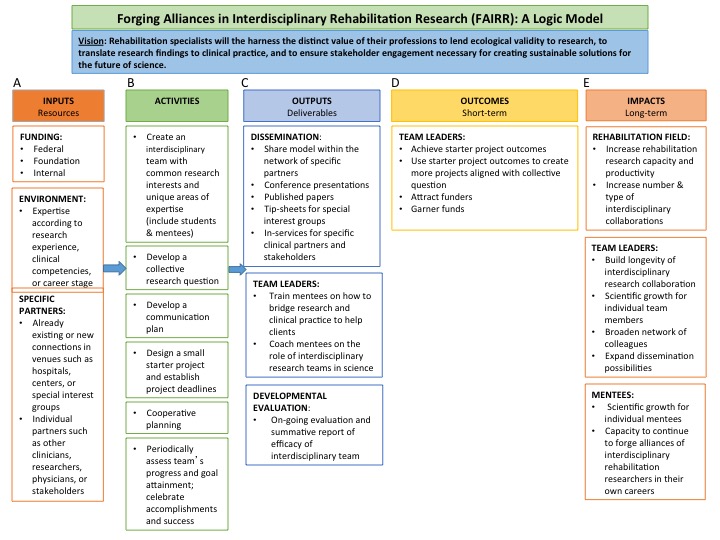
Figure 2. FAIRR Model.
There are five different components that I will go through one at a time. The five components are inputs, activities, outputs, outcomes, and impacts.
Inputs
Figure 3 shows the inputs.
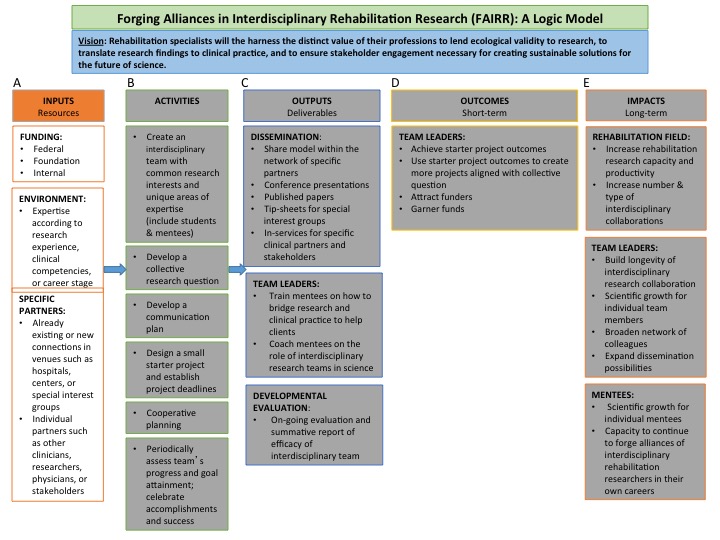
Figure 3. Inputs of the FAIRR Model.
These are the resources that you will need to be able to conduct your science prior to really formalizing all of the members of the team. Do you need funding to be able to pull together the team, and execute the research? Funding can come from federal, foundation, or even internal resources. Your own organization may have internal funding that you could harness to be able to execute the science.
Another example of an input might be the research environment. Is the environment suited to being able to conduct the research with this team? Do you have the equipment that you need to be able to do the work together? Perhaps some members of the team have access to materials that others do not. You also need to determine whether you can pool the materials together or use them in separate spaces. Is there enough space to be able to conduct team science? There may be other members of the team, such as research assistants or doctoral students, who may also need to be housed to conduct this interdisciplinary research.
The critical piece is pulling together the actual team. Finding like minded partners who are really going to be engaged and invested in conducting interdisciplinary research with a like mind or focused on one question that the team wanted to address. Like Leanne mentioned in the very beginning, when you are putting together the team, you will naturally be thinking about what you can bring to the table as a scientist and/or a clinician. This is great, but you will also want to think about what the other members of this team can potentially bring to the group. This is a great way to be able to pair both the strength of some of those researchers and clinicians with weaknesses of others. For example, one colleague may be an expert at grantsmanship, while another colleague might really be astute at creating experiments. You want to create a team that is balanced.
Activities
The second component of our model includes activities (Figure 4).
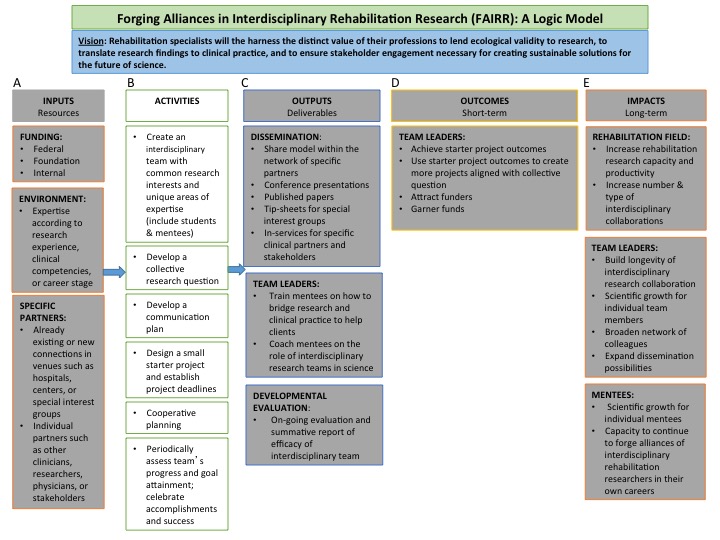
Figure 4. Activities of the FAIRR Model.
These are some of the practical steps that are involved in achieving those outputs, outcomes, and impacts that I will address in a moment. One of these activities might include developing a collective research question that you want to tackle as an interdisciplinary team. This is quite a large activity and comes at the very start of the collaboration.
You might have to come up with a communication plan. How are you going to communicate with one another, in the context of working in this interdisciplinary team? You may want to have colleagues talk about how they best communicate. Some people may prefer to communicate via email while others may prefer face-to-face communication.
How are you going to assess your progress toward your overarching vision and the goal that you created as a team? How do people best work? Some people may really like having mini-deadlines to have small chunks of work to bite off and chew. Others may not need frequent deadlines to feel as though they are accomplishing something. Being able to figure out all of these different activities in terms of communication styles and finding a collective question allows you to learn how to work together as a team. This can be just as important as conducting sound science.
You will also want to identify common goals, and then come up with ways that you are going to achieve those goals. You need to identify which members of the team are going to be responsible for executing different aspects of what you are looking to accomplish as a team. This requires a lot of cooperative planning and active communication.
Outputs
In Figure 5, the third aspect of FAIRR model includes outputs.
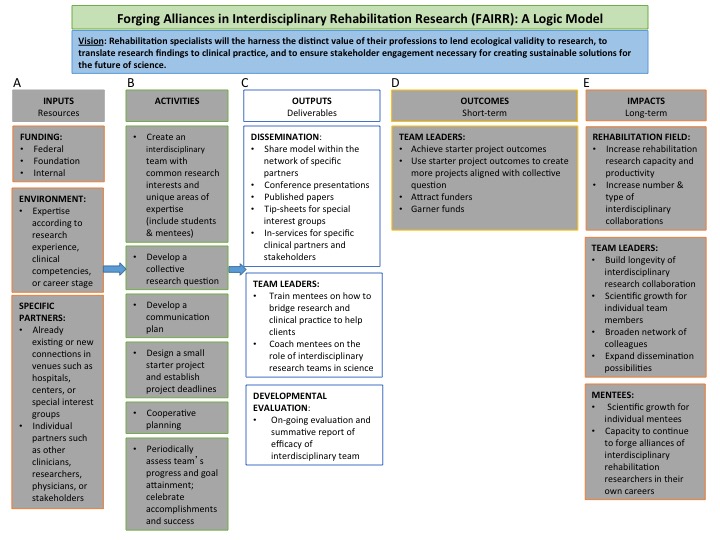
Figure 5. Outputs of the FAIRR Model.
Outputs are the deliverables that you are going to achieve based on what you set out to do. Outputs are linked to the shared goals that you have decided on as an interdisciplinary team. Some of this relates to what Mary discussed earlier when she was talking about challenges. You may need to discuss where to disseminate your research. This disseminatation might be based on your career stage for example. An early career stage investigator may be very eager to publish in discipline specific journals to maintain some autonomy with their own professional language to get feedback from people in their field. They may also do this to feel as though they are being credited with some of the ideas in this research team.


